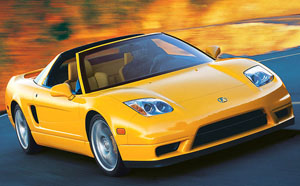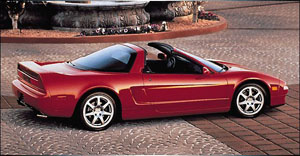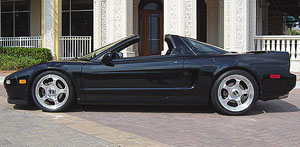The NSX Legacy: Looking back at Honda’s Supercar
When Honda announced last June that they were stopping production of the NSX, it brought a lump to the throat of many a Honda enthusiast. With just under 9000 of the cars ever sold in the United States, the party was over. Offering styling that was more than 15 years old combined with a power plant that the industry had long since passed, NSX sales had dropped to an all time low, and it was time for either a major retooling or extinction. Honda rumors abound, but as yet, a successor to the NSX has yet to be announced.
 This seemed a good time to look back on a truly wonderful car and how it revolutionized the automotive industry. OK Sherman will set the way-back machine for 1988, and we’re off.
This seemed a good time to look back on a truly wonderful car and how it revolutionized the automotive industry. OK Sherman will set the way-back machine for 1988, and we’re off.
Rumors were flying that Honda would be producing a world class supercar. At first, the industry and press scoffed at a Japanese sports car claiming that kind of status. At the time, a new Supra (the closest thing Japan had ever offered here previously) cost around $25k; how could Honda justify a price tag exceeding $65k?!
Then we got our first look…
It was February 9th 1989 when Honda introduced their new mid engine supercar, the New Sportscar eXperimental (shortened simply to NSX), at the Chicago Auto Show. In August of 1990, the NSX went on sale as a 1991 model.
Try and remember the first time you saw an NSX… I’ll bet it’s not too hard. For me it was the showroom floor at an Acura dealer in Burlingame. (Northern California) It was a red one, roped off in the front of the showroom. I was driving past, saw it in the window, and screeched to an immediate halt. (Much to the chagrin of not only my passenger, but the two or three cars behind us as well) I pulled over to the side of the road, explained to my girlfriend that I’d be right back, and ran back to the dealer.
 There it was… Revolving on a turnstile with a velvet rope around it and a sign saying: “DO NOT TOUCH!!!” was the most beautiful car I’d ever seen. A Lotus lover all my life, I’d previously considered the Lotus Esprit as the most beautiful car ever made, but suddenly I was conflicted.
There it was… Revolving on a turnstile with a velvet rope around it and a sign saying: “DO NOT TOUCH!!!” was the most beautiful car I’d ever seen. A Lotus lover all my life, I’d previously considered the Lotus Esprit as the most beautiful car ever made, but suddenly I was conflicted.
The paint was perfect. Up until then, I’d always felt that the one place where American cars were still superior to Japanese cars was in the paint finish and quality, but here was a flawless job with nary a spot of the dreaded “orange peel.” The interior, what I could see of it from behind the rope, was world class, and I dreamed: “some day.”
While the specifications are somewhat sedate by 2006 standards, for 1991 they were phenomenal. The NSX was the first production car with an all-aluminum chassis and body. At only 462 pounds, the aluminum unit body weighs 40% less than steel, with no loss in strength or rigidity. It was powered by 3.0-liter, DOHC, 24-valve, V-6 engine rated at 270 hp and 210 ft lbs of torque and linked to a 5-speed manual transmission, the NSX sped from 0-60 in 5.8 seconds and completed the standing 1/4 mile in 14.4. (These numbers improved to 4.8 and 13.4 by the end of the production run)
The NSX marked the US debut of something we’ve grown to love at S2ki, Honda’s revolutionary VTEC(TM) (Variable Valve Timing and Lift Electronic Control) system. Other NSX innovations included PGM-FI, a fuel injection system pioneered in Formula One racing, as well as a direct ignition system. The NSX was also the first production car to use titanium connecting rods.
Each car was hand-built by a highly skilled team of technicians at the NSX specific Tochigi facility. Production was limited to a maximum of 25 vehicles per day. At $65,000, the NSX was the most expensive Japanese car in history to that point.
Let’s compare that to some of the other mid engine supercars of 1991: (all priced higher than the NSX)
The 1991 Ferrari 348 GTS had a 300 hp V-8 engine with 238 ft lbs torque and a five speed manual transmission. It went from 0-60 in 6.0 seconds and did the standing ¼ mile in 14.3.
The 1991 Lotus Esprit turbo SE featured a twin turbo four cylinder affording 264 HP and 196.9 ft lbs of torque. It went from 0-60 in a blistering 5.1 seconds and did the standing ¼ mile in 13.7.
The 1991 BMW 850i was probably the most expensive and exotic BMW ever made before ’91. The motor was a 296-horsepower 332 ft. lbs. of torque, 5.0-liter V12 matched to a six speed manual or 5 speed automatic transmission. It went from 0-60 in an anemic 7.4 seconds and eventually completed the standing ¼ mile in 15.6.
The automotive industry responded: in 1990 Motor Trend named the NSX to its “Top Ten Performance Cars” list, then in 1991 they called the NSX “the best sports car ever built.” Road & Track called the NSX one of the “Ten Best Cars in the World”, and Automobile magazine named it both “Automobile of the Year” and “Design of the Year.”
Beyond the numbers, and the mid-engine design that offered outstanding handling, and a powerful VTEC engine years before the other car companies jumped on the “variable valve timing” bandwagon… the NSX was just dead sexy! It gave Honda/Acura instant legitimacy as a luxury car manufacturer, and it truly changed the way the whole world thought about Japanese cars.
In truth, the NSX raised the bar for everyone. The fact that Honda could offer such a superior product as the NSX at a significantly lower price than the European competition forced the high end companies out of their complacency. As the years passed, Ferrari introduced the 355, then the 360, and now the 430. Lamborghini introduced the “entry level” Gallardo, Aston Martin introduced the Vanquish, and now the DB9, Porsche continued to improve its venerable 911 line and also introduced the phenomenal Carrera GT. Even Mercedes and BMW got much more serious about their performance offerings with BMW bringing out the M-series and the ill-fated Z8 and Mercedes introducing the very successful AMG offerings and of course the new McLaren SLR.
As all this transpired, the NSX got some minor upgrades in power and handling, and the pop-up headlights were replaced with recessed alternatives. (I liked the old look better.) The interior and sound system also got some upgrades, but the car simply didn’t keep up with the world around it. The end came last year for the NSX, not with a bang, but with a whimper.
I’m reminded of the 1973 World Series… Willie Mays had come in the game for the Mets and was playing the outfield. A routine fly was hit over his head and he set off running to catch it. Willie was well past his prime by then and couldn’t catch up to it; the ball dropped just beyond his reach. It hurt to watch, but it didn’t diminish the fact that in his prime, Mays was the greatest ballplayer in the game. (IMHO) So should it be with the NSX! Let’s try to keep in mind the revolution that the NSX started and not the slow fade at the end.
Last week at an S2ki gathering, several members brought their NSXs. One of them, John, was kind enough to let me take his out for a drive. I have to admit that with all the exotic cars I’ve been lucky enough to drive in my life, I had never had the privilege of taking a spin in an NSX. (John’s my new best friend!)
The styling and technology may be 15 years old, but the car is no less of a thrill to drive.
The first time I drove an S2000, I was reminded of my beloved Lotus’. The S2000 was phenomenally nimble and responsive, and it had something my Lotus’ never did… HORSEPOWER! This is why I love the S2000 so much. On the track or the street, it’s just about as much fun as you can have behind the wheel.
The NSX is a very different experience. Sitting behind the wheel of this car, you’re not thinking Lotus, heck, I’m not even sure if Ferrari is the right description of the feel… I guess the best way I can sum it up is: F-16. While the S2000 is a Spartan sports car par-excelànce… the NSX is an EXOTIC!
As a racing instructor, I get to drive some pretty phenomenal cars on a regular basis, but the NSX made me weak in the knees. I’ve driven cars that cost twice as much and didn’t feel half as good. 100 years from now, that car will still be special. It drives like a dream, has plenty of power, is incredibly nimble for a car of its size, and being behind the wheel of it feels like walking down Main St. on a date with the prom queen.
 There have been many rumors about the future of the NSX. When the HSC (Honda Sport Coupe) was introduced at the Tokyo Auto Show a few years ago with its Enzo-look styling, it was assumed that it the would be the successor to the NSX. No confirmation ever followed. There have been a number of rumors since, but none any more reliable than the XGA rumors started here on April Fools. As in the past, Honda will do what Honda wants to do, and only they know what that is. As for us, the NSX starved, information hungry, public… they’ll let us know when they’re darned good and ready and not a moment before.
There have been many rumors about the future of the NSX. When the HSC (Honda Sport Coupe) was introduced at the Tokyo Auto Show a few years ago with its Enzo-look styling, it was assumed that it the would be the successor to the NSX. No confirmation ever followed. There have been a number of rumors since, but none any more reliable than the XGA rumors started here on April Fools. As in the past, Honda will do what Honda wants to do, and only they know what that is. As for us, the NSX starved, information hungry, public… they’ll let us know when they’re darned good and ready and not a moment before.
As for its Supercar legacy… Some time in the future, when fossil fuel is a thing of the past and they write the history of the automobile, I hope the original NSX gets the full chapter it deserves. This was truly a special automobile.
Discuus this here:
